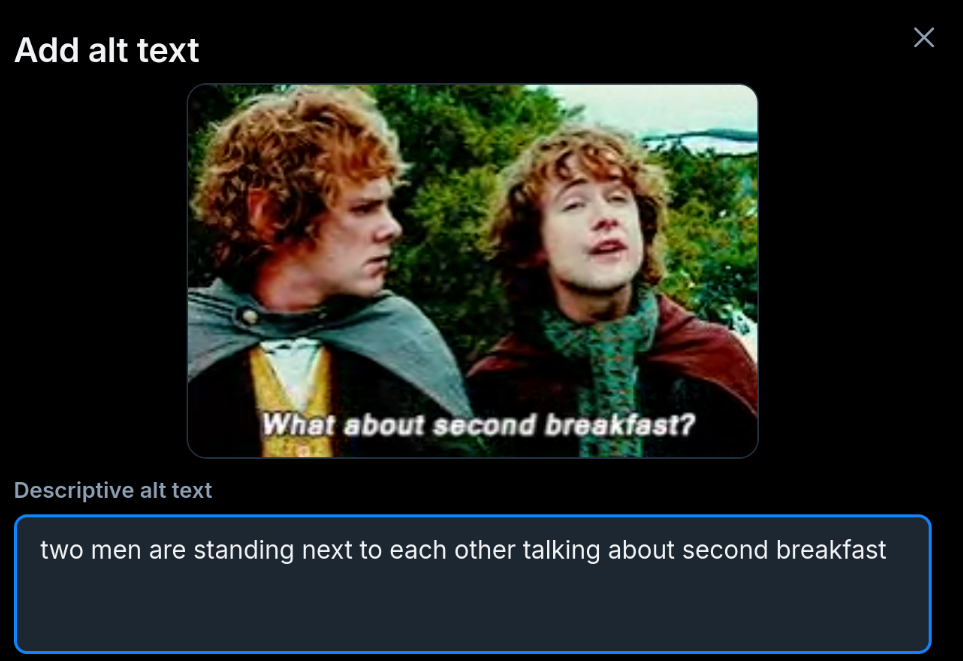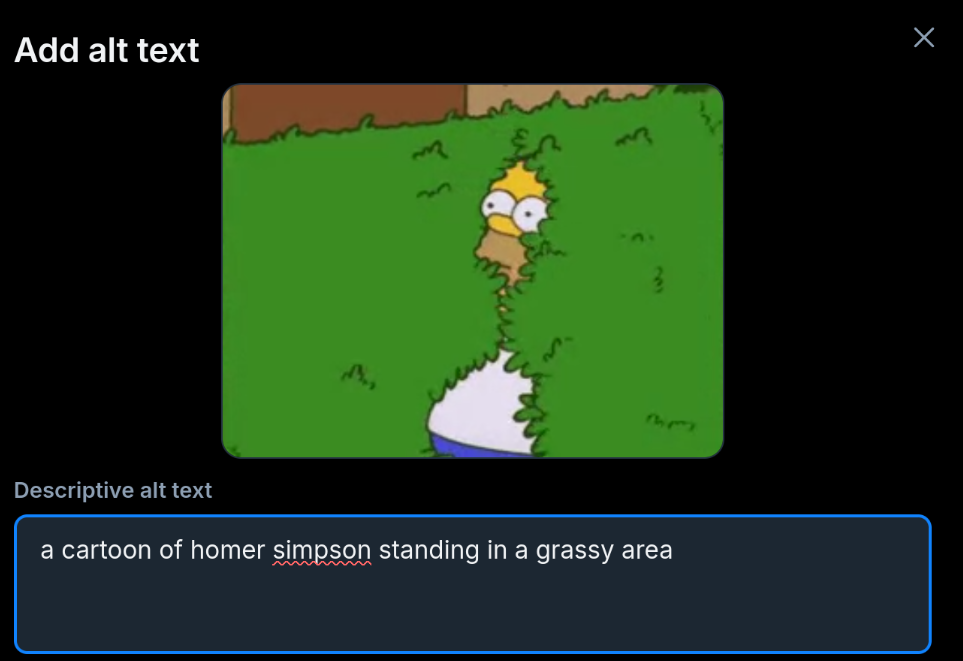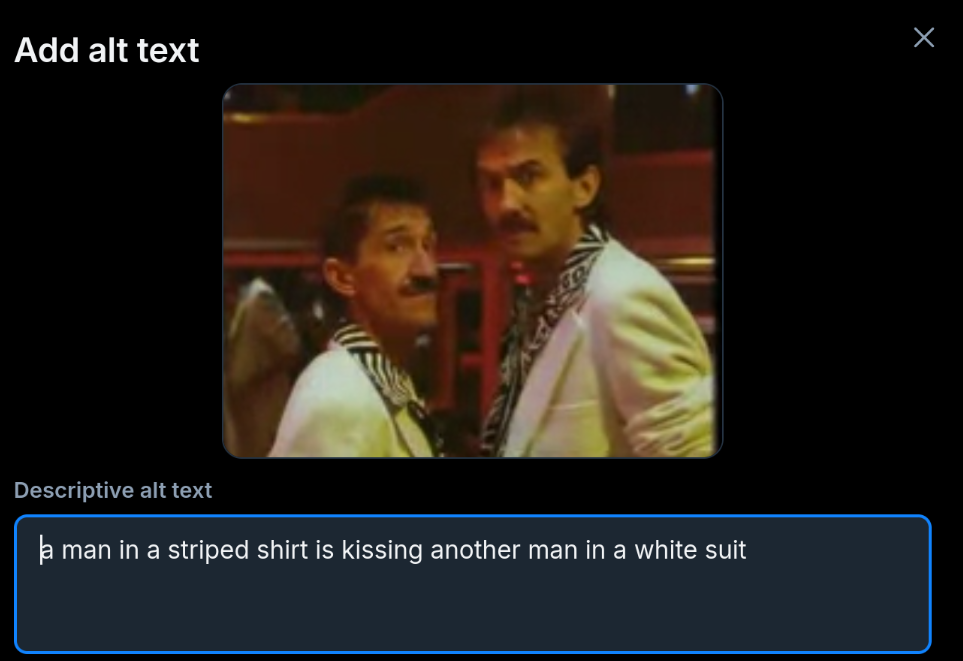Not everyone can see the images you post online. They may have vision problems, they may have a slow connection, or they might be using a text-only browser. How can we let them know what the image shows? The answer is alt text. In HTML we can add a snippet of text to aid accessibility.
For example <img src="monalisa.jpg" alt="A painting of the Mona Lisa.">
Most social networks will let users add alt text to help describe their images. Brilliant!
But... People don't always add alt text when they upload an image. They may not realise it is helpful, or they don't know how to write a good description, or they may not have time to write something suitable. This leads to a frequently asked question: "Should I embed the alt text inside the image file? That way, whenever people share the image the alt text will automatically be attached!"
Here's my attempt to answer that.
Short answer
No.
Long answer
Nooooooooooooo!
Reasoned Answer
It is complicated.
On a technical level, yes. Most modern image formats allow you to add image metadata - known as EXIF. This EXIF commonly contains GPS location, timestamps, make and model of camera, etc. Here's an example from one of my photos:

There are a pre-defined list of acceptable EXIF tags one of which is "ImageDescription", which is defined as:
A character string giving the title of the image. It may be a comment such as "1988 company picnic" or the like. Two-byte character codes cannot be used. When a 2-byte code is necessary, the Exif Private tag UserComment is to be used.
So, there you have it. Yes you can embed text inside an image. With the right software you can read it. So, technically, you can stuff alt text in there and have a website automatically add it to the alt attribute.
But this is only half the story. What an image represents is highly context dependent.
In her article about using AI to automatically provide image captions, Léonie Watson makes that point that alt text needs to be:
provided by a content author who knows exactly what's in the image, why its being used and the context its being used in.
Take this very real photo of a famous actress who I just got an AI to dream up.

What's a suitable alt text for this image?
- Famous actress Claire Flumptron standing on the red carpet.
- Claire Flumptron shows off her brand new arm tattoo which has strange mystic runes covering her forearm.
- Designer Giovanni Tuccini's new red dress has a small strap over the shoulder.
- AI image where the hand is strangely deformed and the neck looks twisted beyond human endurance.
- Smiling woman with cropped blonde hair and heavy eye makeup.
- Last known photo of the Mayor (right). His blurry face is smiling.
- ...
There's no "right" answer. It depends on what the image is being used to illustrate.
A picture may be worth a thousand words. But those thousand words depend on context.
Update Here's another good example of embedded alt text failing badly.
For more information on writing good alt text, see Harvard's Digital Accessibility blog and Design102's guide.




11 thoughts on “Should you embed alt text inside image metadata?”
@Edent It's also worth remembering that the instance admin (on Akkoma at least) can configure Exif data to be stripped out.
https://akkoma.dev/AkkomaGang/akkoma/commit/c06a5af386a3cdfeda0b2c21963d9200fb7d6c89akkoma
| Reply to original comment on stroud.social
@Edent Ha, I was just today making the opposite request 🤣 Admittedly that was only tangentially suggesting that the description should be in the image. I had... other concerns. friendica.exon.name/display/97…Roni Laukkarinen
| Reply to original comment on friendica.exon.name
That's a bummer. It means
ImageDescriptiontag is obsolete, as it doesn't support most of the languages from so many countries around the world.@Edent This post got me thinking about the "thumbnail" images that get embedded in RSS feeds, and how they don't have alt-text. So (among other RSS changes I was making anyway today) I started adding <media:description />s to my blog's RSS feeds!
Thanks for the inspiration. Here's the result: https://danq.me/better-wordpress-rss-feedsBetter WordPress RSS Feeds
| Reply to original comment on m.danq.me
Funny you post this, a revitalized mastodon app is getting this exact feature added. It extracts the metadata caption and inserts it as the suggested alt text (tho you are presented with the value can change it). I never thought about the metadata being uploaded to the server (including location data yikes) so I’m hoping the fediverse is doing the right thing and stripping that data before uploading…
@edent
It almost certainly doesn't strip before uploading. But it will probably strip before storing and displaying. That's how most services do it.
@Edent IPTC also announced two specific tags for accessibility descriptions instead of the the generic caption, which might not always prioritise accessibility concerns. You can see a nice example at https://www.publishersweekly.com/pw/by-topic/digital/content-and-e-books/article/87947-how-publishers-can-get-alt-text-right.html, on where these differences matter.
https://www.scribelytribe.com/post/one-giant-leap-for-accessibility-meet-the-new-photo-metadata-standardsHow Publishers Can Get Alt Text Right
| Reply to original comment on tatooine.club
@Edent @simevidas I certainly agree that a default image description shouldn't be used automatically without prompting the content author to review / edit it. But there are also lots of times when it would be good enough, or a good start.
From that perspective, there is a difference between passing the metadata silently inside the image file and passing it as a complex data object that can be used to pre-populate an alt text field.
| Reply to original comment on front-end.social
@Edent "so you end up with wrong alt text" wrong!
My suggestion is that you have to choose between using the provided alt-text, editing it or writing your own while uploading media.
Why does everyone act like metadata is as flexible as text carved in stone?
You then choose whether you want to overwrite the files alt text or have yours just display with your post (because the previous is more general and yours focuses on what you're trying to convey with your specific post for example).
This whole suggestion is not to get people who don't care about providing good alt text off the hook, but to make life a little easier for those who do care.
| Reply to original comment on climatejustice.social
What I kind of want for Bluesky (and indeed any federated system, but it fits well with Bluesky's composable bits) is to layer in a feed of good alt text. If I had a way to sometimes write better alt text for someone else's image, I would. No idea how many others would, admittedly.
| Reply to original comment on bsky.app
@Edent So what? Nothing about having alt text embedded in EXIF data stops you from being able to edit it for specific contexts in the rare cases where it needs to be.
I just want it to be easier to make my images accessible. Being able to compose thoughtful descriptions in advance, once, rather than again and again every time the image is used would solve 95% of the use cases better than what we currently have.
Don’t make accessibility harder than it needs to be.
| Reply to original comment on federate.social
More comments on Mastodon.